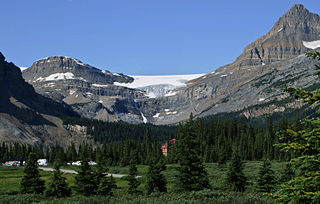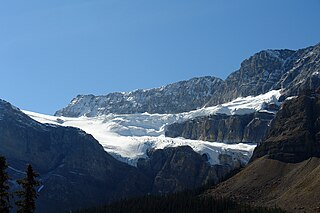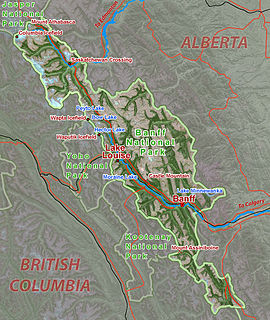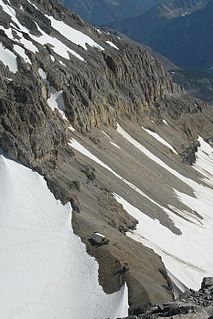| Peter and Catharine Whyte Hut | |
|---|---|
| General information | |
| Type | alpine hut |
| Architectural style | Metal Shelter cabin |
| Location | Bow Valley |
| Country | |
| Coordinates | 51°39′48″N116°32′42″W / 51.66333°N 116.54500°W |
| Owner | Alpine Club of Canada |
| Technical details | |
| Material | Metal |
| Design and construction | |
| Architect | Alpine Club of Canada |
| Website | |
| www.alpineclubofcanada.ca/facility/peyto.html | |
The Peter and Catharine Whyte Hut, also known as the Peyto Hut, is an alpine hut located on the northern tip of the Wapta Icefield in Banff National Park. It is nicknamed the Peyto hut due to its proximity on the Peyto Glacier. The hut is maintained by the Alpine Club of Canada.
The Wapta Icefield is located on the Continental Divide in the Waputik Mountains of the Canadian Rockies, in the provinces of British Columbia and Alberta. The icefield is shared by Banff and Yoho National Parks and numerous outlet glaciers extend from the icefield, including the Vulture, Bow and Peyto Glaciers. Runoff from the icefields and outlet glaciers supply water to both the Kicking Horse and Bow Rivers, as well as numerous streams and lakes.

Banff National Park is Canada's oldest national park and was established in 1885. Located in the Rocky Mountains, 110–180 kilometres (68–112 mi) west of Calgary in the province of Alberta, Banff encompasses 6,641 square kilometres (2,564 sq mi) of mountainous terrain, with many glaciers and ice fields, dense coniferous forest, and alpine landscapes. The Icefields Parkway extends from Lake Louise, connecting to Jasper National Park in the north. Provincial forests and Yoho National Park are neighbours to the west, while Kootenay National Park is located to the south and Kananaskis Country to the southeast. The main commercial centre of the park is the town of Banff, in the Bow River valley.
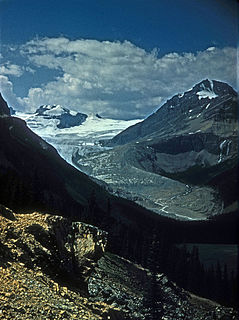
The Peyto Glacier is situated in the Canadian Rockies in Banff National Park, Alberta, Canada, approximately 90 km (56 mi) northwest of the town of Banff, and can be accessed from the Icefields Parkway. Peyto Glacier is an outflow glacier from the Wapta Icefield, which rests along the Continental divide. The glacier snout is subject to high melt rates from season to season and there is marked surface lowering on several parts of the glacier. Glacial silt, which is carried from the glacier by streams, ensures a turquoise appearance to Peyto Lake, a popular tourist destination. As is true for the vast majority of glaciers worldwide, Peyto Glacier has been retreating rapidly, especially since the last half of the 20th century, and has reportedly lost 70% of its mass since it was first researched (Demuth and Keller, 2006). Between 1896 and 1966, the total volume loss of the Peyto Glacier was 1088.5 x 106 m3 (Wallace, 1995). In 1987, an automatic weather station was constructed near the glacier that monitors temperature changes, radiation, and precipitation
The hut sleeps 18 in the summer and 16 in the winter. It is equipped with propane powered lamps and stovetop. [1] There is a single outdoor drum toilet at this facility.
Hut access requires approximately 6 to 8 hours of travel [2] including at least an hour of glacier travel to get to from Peyto Lake, or 6 to 8 hours of glacier travel from the Bow Hut.

Peyto Lake is a glacier-fed lake in Banff National Park in the Canadian Rockies. The lake itself is easily accessed from the Icefields Parkway. It was named for Bill Peyto, an early trail guide and trapper in the Banff area.
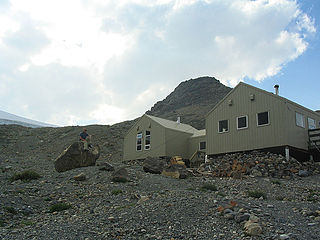
The Bow Hut is an alpine hut located at an elevation of 2,350 metres (7,710 ft) on the eastern edge of the Wapta Icefield in Banff National Park. It is the largest, best equipped, and most accessible of the four alpine huts on the Wapta Icefield, and serves as the base for a wide variety of ski tours and mountaineering ascents to half a dozen peaks on the Wapta. It is the easiest and safest starting point for the Wapta traverse; and Balfour Hut, the next hut on the traverse, can easily be reached from it in a day. It can also serve as an intermediate stop in a longer traverse which starts at the less easily accessible Peyto Hut. The hut is maintained by the Alpine Club of Canada.


